• James Cook was a top-12 RB last season: The Buffalo Bills top running back has played well as a runner and there is plenty of reason to believe he will see more opportunities this year.
• Touchdowns are the main problem: Cook only ran for two touchdowns last season and he might not see many goal-line touches this season either.
• Get a head start on fantasy football: Use PFF's fantasy football mock draft simulator to create real live mock draft simulations to get ready for your live draft!
Estimated reading time: 6 minutes
The player profile series gives the most in-depth view of a player possible using the best data points at PFF’s disposal to look at how good the player has performed, what competition the player has for touches, and how other teammates and coaches will impact each player's performance.
Last updated: 7:15 a.m. Tuesday, July 9
Player performance
Cook showed he could be a versatile runner in his second season, playing well in gap or zone plays while playing particularly well even when plays weren’t perfectly blocked or he faced an eight-man box. He’s been particularly good at consistently breaking longer runs but not at breaking long runs for touchdowns.
His only three 25-plus-yard runs were in the last five minutes of games where the Bills were either running out the clock or expected to pass while trying to catch up. He only scored two rushing touchdowns during the regular season.
As a receiver, he was given plenty of opportunities but wasn’t necessarily efficient in catching the ball. Luckily more of his receptions ended up scoring touchdowns, helping his EPA on receptions as well as his fantasy value.

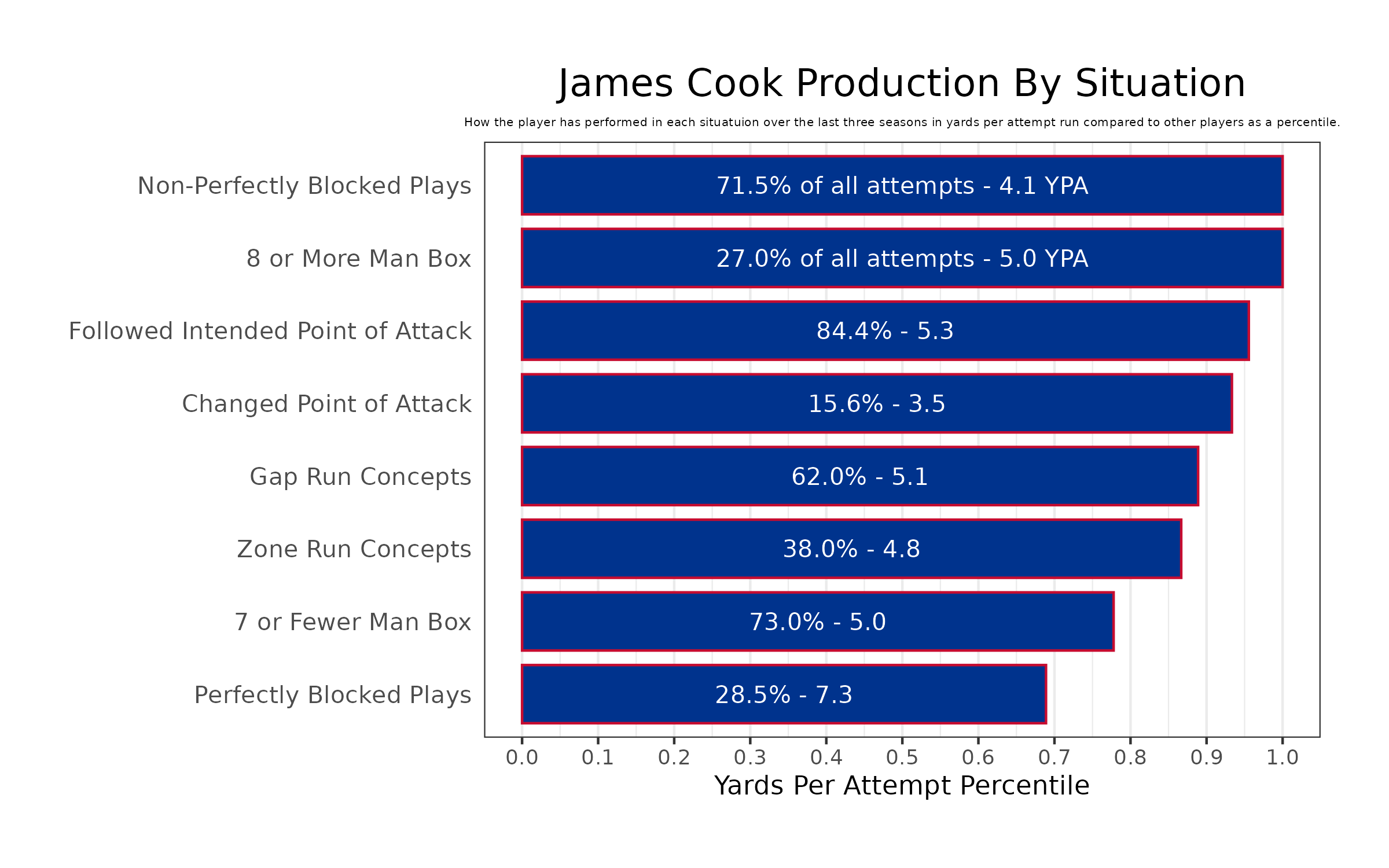

Competition for touches
Cook took major steps forward in his utilization from his rookie year to his sophomore, playing significantly more snaps in every situation while receiving the ball roughly the same amount while he was on the field.
His playing time fluctuated throughout the season. From Weeks 1-5, he was consistently playing at least 59% of Buffalo's offensive snaps, but after five carries for -4 yards in Week 5, his snap count was reduced. He played less than 50% of Buffalo's offensive snaps in five of the following eight games. He then ran 25 times for 179 yards and a touchdown, and he set a career-high in percent of offensive snaps the following week at 75%.
During the playoffs, his playing time decreased again, but he was getting the ball much more often when he was on the field. He ran the ball 18 times and caught four passes in both playoff games. Those games were tied for his second-most touches in a game.
Latavius Murray and Damien Harris were his primary competition early in the season but neither is on the 2024 roster. Leonard Fournette signed in the middle of the season but only ended up playing 26 snaps. Ty Johnson has mostly been a receiving back in his career and could have that role again while Ray Davis was signed in the fourth round.
After how much the Bills relied on Cook in the playoffs and their lack of veteran additions this offseason, it might be a sign the Bills finally trust Cook to be their clear lead back, which could mean an even bigger role this season. It’s also possible Ray Davis makes this a committee.
The other question for Cook is goal-line touches. He ran the ball four times when the Bills were within four yards of scoring, which isn’t nearly enough. The other running backs had 13. It’s possible Davis gets those carries given his size relative to Cook. The bigger problem is Josh Allen, who ran 15 times in those situations. Ideally, Cook gets more goal-line carries, but even if he doesn’t, we could expect similar touchdown production to last season, if not better with more breakout runs for touchdowns.
The Bills also lost Stefon Diggs and Gabe Davis at wide receiver. They invested in multiple replacements, but no one can fully replace Diggs. It’s also possible Cook doesn’t see a significant increase in snaps, but gets the ball more often when he’s on the field like they did in the playoffs. If he sees both an increase in snaps and gets the ball more, then a top-10 fantasy season is easily within his reach.

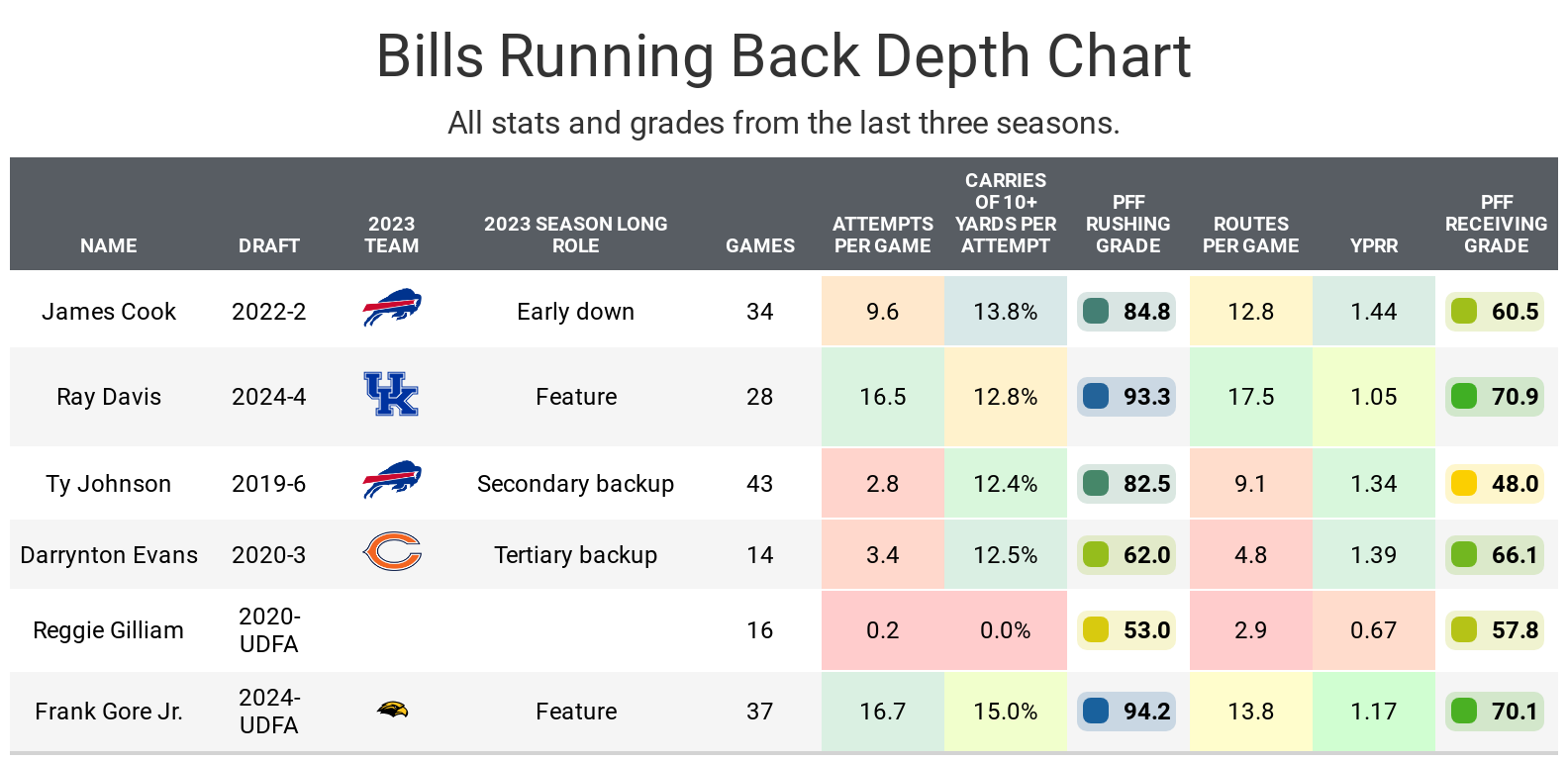
Impact of teammates
Ken Dorsey was fired as Bills offensive coordinator following Week 10, so Joe Brady took over from Week 11 on. That corresponds closely to when Cook started receiving the ball more often when he was on the field. He averaged 12 carries and 2.4 receptions per game in 2023 with Dorsey and 17 carries and 3.1 receptions per game with Brady.
Brady also has history as an offensive assistant with the New Orleans Saints where Alvin Kamara was RB4 and RB3 during the two years Brady was on the staff. He was also the Carolina Panthers offensive coordinator the two years Christian McCaffrey dealt with injuries, but McCaffrey still averaged 21.6 PPR points per game in the few games he was healthy.
Cook should not only benefit from another year with Brady as offensive coordinator but also some continuity on the offensive line. The Bills had some great injury luck on the offensive line last season with all five starters playing over 1,100 snaps each. Center Mitch Morse signed with the Jacksonville Jaguars in free agency, but Morse was a better pass blocker than run blocker. Connor McGovern is moving over to make way for David Edwards, who is a better run blocker than pass blocker.
The line should play a little better this season given their continuity and where they are at in their careers, which should also be a positive for Cook.
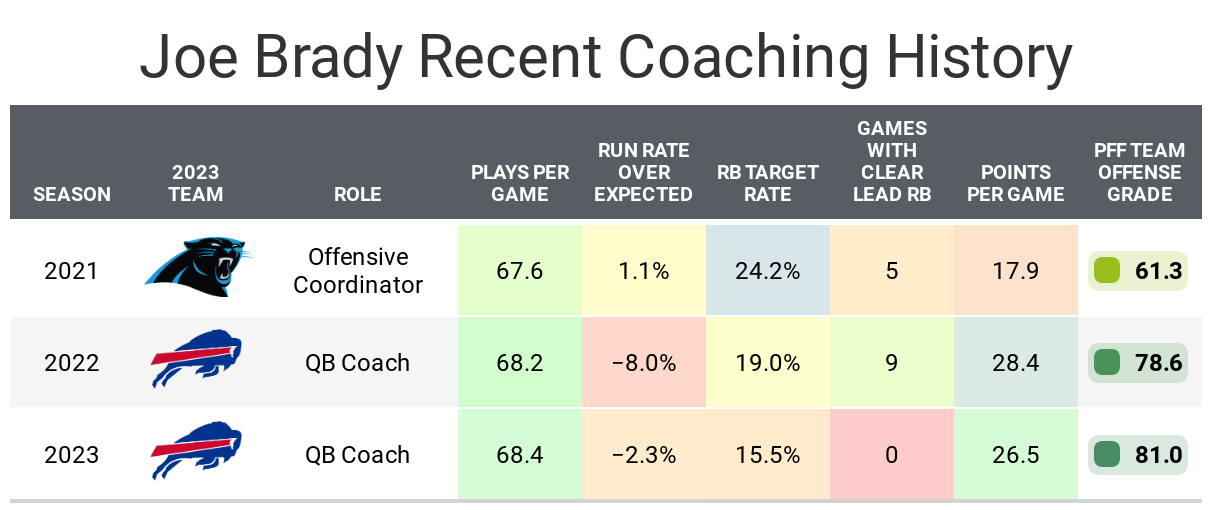
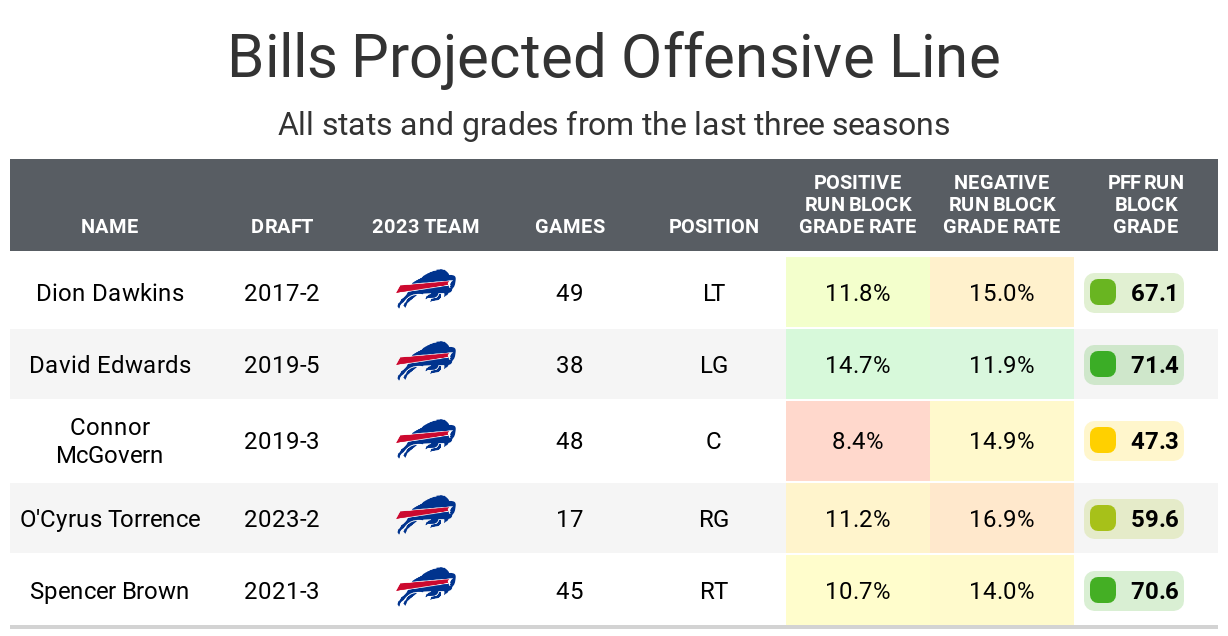
Bottom line
Cook finished at RB12 last season in part thanks to his ability to stay healthy, but a number of factors, including less veteran competition, the offensive coordinator change, continuity on the offensive line and the Bills not being as strong, all point to Cook seeing more opportunities this season. A lack of goal-line opportunities will probably prevent him from finishing among the top-five running backs, but top-10 is a strong possibility if he can stay healthy.

Footnotes
- Statistics for the tables and charts were generally chosen based on their ability to predict future fantasy performance on either per game or per opportunity basis, or chosen for their ability to describe the player relative to other players at the same position.
- Opportunities for this purpose are defined by passing dropbacks, rushing attempts and receiving routes run.
- Numbers are either by season or based on the last three years. For rookies, only college numbers are included. For non-rookies, only NFL numbers are included, even if they played in college in the last three years.
- Because college competition is relatively easier than NFL competition, it can be expected that most rookies will see a decline in their numbers compared to their historic numbers.
- For all of the tables in this article, colors range from blue (good or high) to red (bad or low).
- All percentiles or colors compare the given player to other players with a high sample of opportunities. Generally, it’s one-third of the possible opportunities given the sample. If the player in question doesn’t have enough opportunities, they are still compared, even though a player could look good or bad on that small sample size which might not be as predictive.
- Information on running back utilization classifications and importance can be found here, wide receiver here and tight end here.
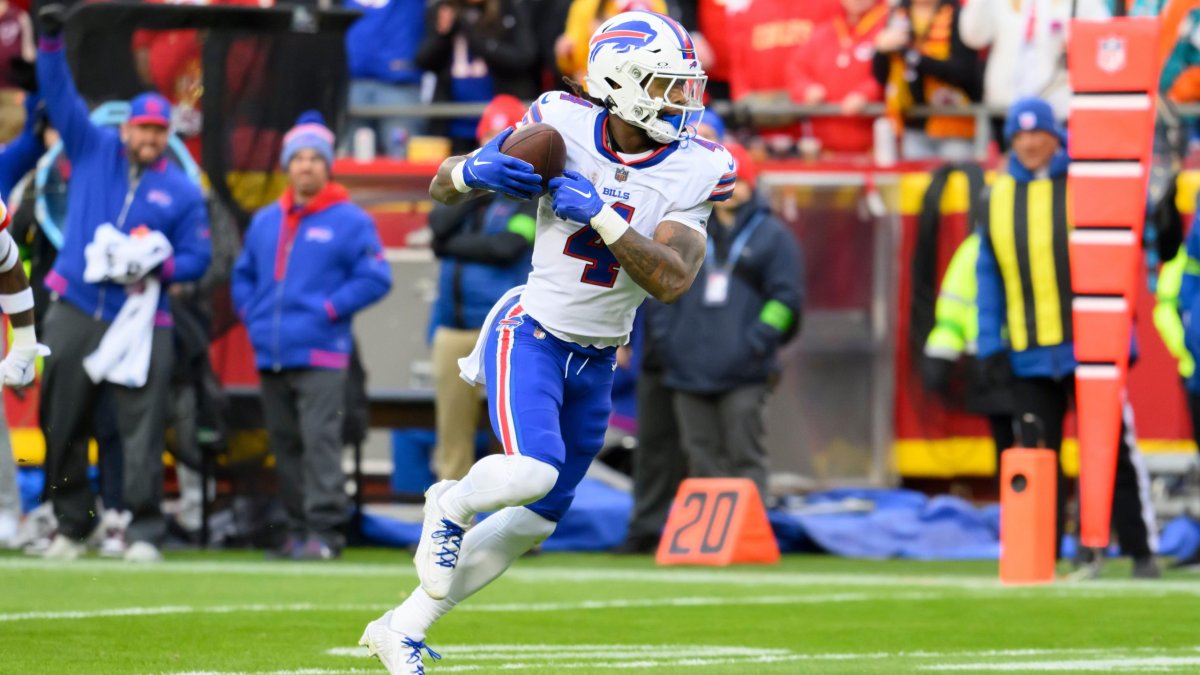



 © 2025 PFF - all rights reserved.
© 2025 PFF - all rights reserved.